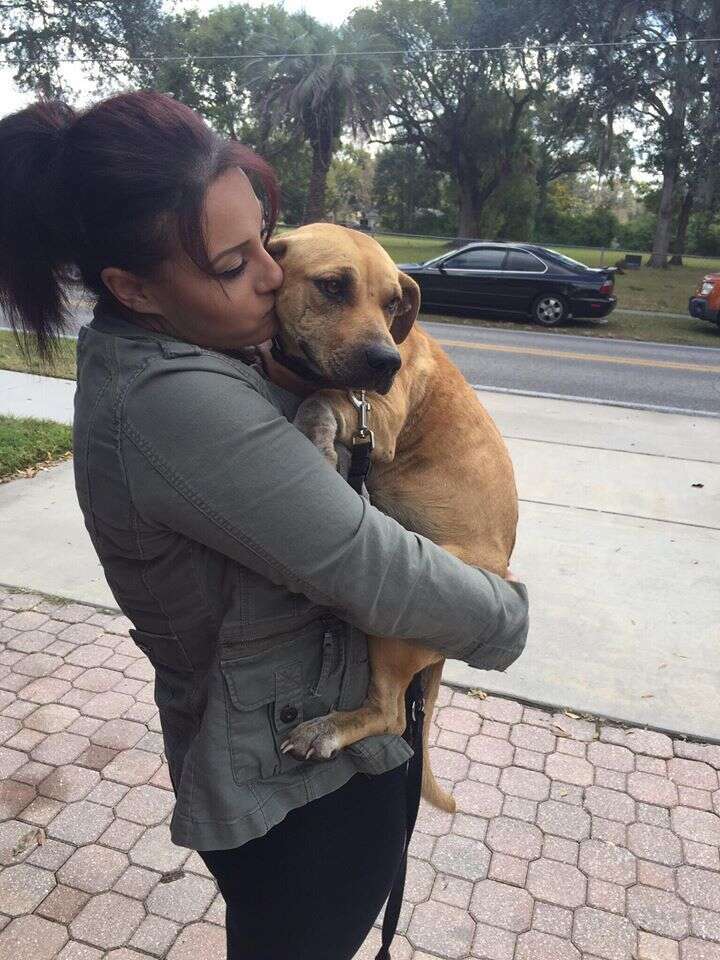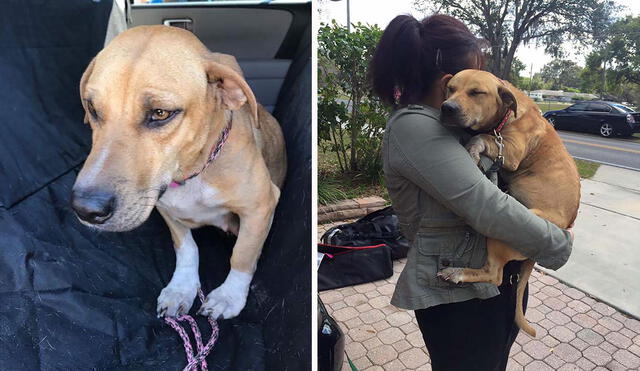Rescued from the Shadows: The Heartbreaking Story of a Dog Who Needed Love More Than Anything
When they found her, she was curled up in a corner of an abandoned lot, trembling like a leaf. Her skin clung to her bones, her eyes avoided all contact, and her body bore the marks of a painful past: scars, patches without fur, and above all, a deep, overwhelming distress. No one knew exactly what she had been through. But one look was enough to understand that her heart had been broken far too many times.
She had been forgotten, left behind in a world that had shown her little kindness. Passersby had noticed her before, but no one had stopped. She was invisible to the very humans who were meant to care. That day, however, her fate took a different turn. A volunteer from a local animal rescue group arrived, drawn not just by duty, but by an unshakable sense that this trembling creature needed someone to believe in her.
Gently, carefully, the rescuer approached. Each step toward her was met with a slight shiver, a tentative retreat, a hesitant glance filled with both fear and hope. The dog didn’t understand that help was finally here. She had learned to expect the worst, not the best. Her first interactions were tentative. She flinched at sudden movements, pulled back from extended hands, and whimpered softly when touched. But the rescuer persisted, speaking in a calm, reassuring voice, offering tiny treats, and allowing her to set the pace.
It wasn’t just a rescue—it was the beginning of a journey toward trust, toward healing, and ultimately, toward love. At first, the simple act of feeding her without frightening her was a victory. Each soft word, each gentle stroke, slowly chipped away at the wall she had built around her heart. For every scar on her body, there was a story of survival; for every patch of missing fur, a testament to endurance. Yet, beneath the physical wounds, the emotional scars ran deepest. She had been hurt by humans before, perhaps abandoned, neglected, or worse. And yet, somehow, she still had the capacity to learn that kindness existed.
Bringing her into a safe space was the first step in rewriting her story. The small foster home that welcomed her was quiet, warm, and patient. Here, she was free from the fear of the streets, free from the hunger that gnawed at her ribs, and free from the constant uncertainty that had defined her days. But freedom alone could not heal her. Healing required patience, consistency, and unwavering love.
The initial days were quiet and tense. She hid under furniture, avoided eye contact, and sometimes seemed to shrink from her own shadow. Every new sound, every unfamiliar movement, could trigger her instinct to flee. Yet, gradually, small signs of trust began to appear. A wag of the tail, hesitant at first, then braver with each passing day. A soft nuzzle against the hand that fed her. Eyes lifting to meet a gaze without fear. It was a slow, delicate process—a dance of trust that required empathy and understanding at every step.
Veterinary care was essential. Her body bore the evidence of starvation, neglect, and possibly abuse. Each scar told a story of pain endured and resilience maintained. Treatments were administered gently, vaccinations and medications were given with care, and nutrition was slowly restored, each meal a step toward strength and vitality. She began to put on weight, and her coat, once dull and patchy, began to shine faintly under the loving care she now received.

But even as her physical wounds healed, the emotional ones required the greatest care. She had to learn that humans could be safe, that she no longer needed to fear every hand that reached toward her, every voice that called her name. Patience became the cornerstone of her recovery. The volunteers celebrated small victories: when she allowed herself to be held, when she sought attention instead of retreating, when she dared to play with toys without suspicion. Each moment of trust reclaimed was a triumph, a reaffirmation that love, no matter how delayed, could reach even the most broken hearts.
Slowly, she began to transform. Her posture straightened, her eyes gained a spark of curiosity and joy, and the trembles of fear were replaced with tentative confidence. She discovered the joy of walks, the delight of soft beds, the security of a loving voice. She began to respond to her new name, learned to interact with other animals, and discovered that the world could be a place of safety and happiness, not just pain and uncertainty.
Her journey is far from over, but the path ahead is filled with hope. She is a living testament to resilience and the transformative power of compassion. Every scar on her body, every hesitant glance, tells the story of survival—but also of the extraordinary capacity to love again.

For those who encounter animals like her, her story is a reminder: patience, kindness, and empathy can rewrite even the darkest chapters. Rescue is not simply about saving a life—it is about restoring trust, healing wounds, and proving that love can reach the most hidden corners of the heart.
Today, she thrives in a home that celebrates her presence, where she is cherished and adored, where each day brings a new adventure, a new friendship, and a deeper understanding of the joy she now deserves. Her transformation is more than physical; it is emotional, spiritual, and deeply inspiring. She stands not just as a survivor of hardship, but as a symbol of hope, a living proof that even the most broken hearts can heal with patience, care, and unwavering love.
Her story is a call to action for all of us. There are countless animals waiting in the shadows, trembling in fear, overlooked and forgotten. Each one has a story, a past that may be painful, but also a future that can be brightened by kindness. By fostering, rescuing, or simply spreading awareness, we can make a difference. Each small act of love reverberates far beyond the moment—it changes lives, restores hearts, and proves that hope is never truly lost.
She is no longer just a shadow in an abandoned lot; she is a living reminder that love can heal, that resilience can triumph, and that every being, no matter how broken, deserves a chance at happiness.
A Teacher’s Promise: How Mr. Brown Made a Graduation Unforgettable

In the small halls of the Skagit County Juvenile Detention Center, education is more than textbooks and lessons—it is hope. For many young people, the weight of past mistakes can feel suffocating, and the idea of a better future can seem almost unreachable. Yet, in the midst of confinement and struggle, there are educators who do more than teach—they transform lives. This is the story of Mr. Brown, a teacher whose small acts of kindness became monumental moments of joy for the students under his care.
I first met Mr. Brown when I was fifteen, navigating the confusing and often harsh world of juvenile detention school. Even then, it was clear that he was unlike any other teacher. He didn’t just focus on lessons and grades—he focused on us, the kids, as human beings capable of growth and change. He was the type of teacher who celebrated every small success, who saw the person behind every misstep.
One day, in a conversation that would stay with me for years, I learned something extraordinary. Mr. Brown had a tradition: he attended graduations of past inmates, bringing pizza and fun treats. It wasn’t required. It wasn’t part of his job description. But he believed that no matter where life had led a student, milestones deserved to be celebrated, and achievements deserved recognition.
During that conversation, I teased him. I told him he should come to my graduation wearing a dress. He laughed, a deep, genuine laugh that filled the room, and said, “Cesar, I’ll even jump up and down and say that’s my son!” That moment was simple. A joke. A shared laugh between student and teacher. And yet, it was also a profound gesture of support, of acceptance, and of unconditional encouragement. I smiled, said okay, and went on with my day, never fully realizing the weight of that promise.
What Mr. Brown did for me that day, and what he has done for countless students like me, goes beyond celebration. It is a statement: that no one is defined solely by their past, that joy is still possible, and that someone believes in your future. In the walls of a juvenile detention center, where despair often lurks, Mr. Brown provided a lifeline.
Graduation day arrived, and Mr. Brown was there, true to his word. Whether he wore a dress or simply jumped up and down in mock pride, the message was clear: I was not alone. Someone cared enough to witness my achievement in a way that transcended conventional boundaries. That act of humor, love, and affirmation became a memory I carry with me to this day—a reminder that small gestures of kindness can leave a lifetime impact.
Stories like Mr. Brown’s are often overlooked in the media or in our daily conversations, yet they are vital. They remind us that education is not just about academics, and teaching is not merely about instruction. True educators invest in the hearts and souls of their students. They champion their victories, share in their laughter, and create safe spaces for growth—even when society has judged those students harshly.
In a world quick to label, quick to punish, and slow to forgive, Mr. Brown’s actions are revolutionary in their simplicity. A pizza, a joke, a graduation hug—small gestures that declare to young people: You matter. You belong. You are seen.
For me, this experience shaped how I view mentorship, kindness, and the ripple effects of compassion. It instilled a sense of possibility at a time when the horizon seemed bleak. It taught me that laughter and encouragement can coexist with discipline and learning. And most importantly, it showed that the bond between teacher and student can change lives, one heartfelt moment at a time.
To this day, when I think of Mr. Brown, I think of more than a teacher. I think of a champion, a supporter, a human being willing to step outside the lines to ensure that someone else’s day was brighter, their accomplishment celebrated, and their dignity affirmed.
In the end, that story of a teacher promising to jump up and down and call me his son may seem like a small anecdote—but it is emblematic of a greater truth: compassion, humor, and love are powerful forces that can transform even the most unlikely spaces. And it all started with a simple joke between a student and a teacher who refused to let the world define what success should look like.







